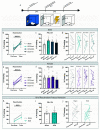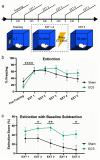Electroconvulsive Shock Does Not Impair the Reconsolidation of Cued and Contextual Pavlovian Threat Memory
- PMID: 32992904
- PMCID: PMC7582782
- DOI: 10.3390/ijms21197072
Electroconvulsive Shock Does Not Impair the Reconsolidation of Cued and Contextual Pavlovian Threat Memory
Abstract
Existing memories, when retrieved under certain circumstances, can undergo modification through the protein synthesis-dependent process of reconsolidation. Disruption of this process can lead to the weakening of a memory trace, an approach which is being examined as a potential treatment for disorders characterized by pathological memories, such as Post-Traumatic Stress Disorder. The success of this approach relies upon the ability to robustly attenuate reconsolidation; however, the available literature brings into question the reliability of the various drugs used to achieve such a blockade. The identification of a drug or intervention that can reliably disrupt reconsolidation without requiring intracranial access for administration would be extremely useful. Electroconvulsive shock (ECS) delivered after memory retrieval has been demonstrated in some studies to disrupt memory reconsolidation; however, there exists a paucity of literature characterizing its effects on Pavlovian fear memory. Considering this, we chose to examine ECS as an inexpensive and facile means to impair reconsolidation in rats. Here we show that electroconvulsive seizure induction, when administered after memory retrieval, (immediately, after 30 min, or after 1 h), does not impair the reconsolidation of cued or contextual Pavlovian fear memories. On the contrary, ECS administration immediately after extinction training may modestly impair the consolidation of fear extinction memory.
Keywords: ECS; ECT; consolidation; electroconvulsive shock; fear conditioning; fear extinction; reconsolidation.
Conflict of interest statement
The authors declare no conflict of interest.
Figures




References
MeSH terms
Grants and funding
LinkOut - more resources
Full Text Sources
Medical

